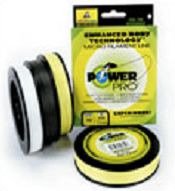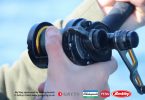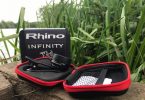PowerPro Fishing Line
by Jeremiah T. Bagwell
|
|
||||||||||||||||||||
|
Every angler knows that one of the most vital aspects of fishing is your fishing line. Still several anglers ignore this fact and do not take the necessary steps to ensure that they will land that catch of a lifetime once it is hooked. Myself and several other anglers have done several hundred hours of “on the water” research to try to determine which line best suites our needs. The line that I use for nearly every application is PowerPro. In this review, I will get in detail about some of the different characteristics of the fishing line of the future.
General Information: PowerPro is a braided Spectra® fiber. When PowerPro is manufactured, the company uses Enhanced Body Technology™ to produce an extremely round and ultra sensitive fishing line. The line lies very nicely in any reel.
Putting PowerPro on your reels: Because of the material that PowerPro is produced from, it is necessary to place some sort of backing on your reel before spooling up with PowerPro. This will prevent the line from slipping on the spool when pressure is applied. I have found that one of the best materials for backing the spool is monofilament. Simply place the monofilament on the spool as you would if you were going to fill the reel. Once the entire width of the spool is covered use a Uni knot to Uni knot to attach the PowerPro to the monofilament. After the knot is secure, continue to fill the reel to its maximum capacity with PowerPro.
Best Knots for use with PowerPro:
Cutting PowerPro: As a result of the lines extreme durability, you can not cut this line as easily as monofilament without the proper tools. You will need to purchase a very sharp pair of scissors. Several companies make scissors that will effectively cut PowerPro, but it is not necessary to spend a great deal of money. A pair of sharp Fiskars® children’s scissors will do the job. The scissors that I used during the testing of PowerPro were braided line scissors from Wal-Mart. They retail for about $3.50 per pair.
Setting your reels drag: Although I use high quality Rogue rods it is important to properly set the drag as to not cause damage to the rod. Not every company designs their rods to handle the amount of power unleashed during PowerPro hook sets. There are several methods that you can use to effectively set your drag. You can set it to match the weakest point in your equipment, set to the rating of the monofilament that you normally use or in my case, I just set it to the point where I can pull out the line with an average amount of pressure by hand. You can adjust your drag while fishing if it appears to be too tight or too loose. No stretch lines can be tough on the gears in light reels. Also, since you are not losing power down the length of the line as with monofilament, you will not loose hook setting ability.
Casting: Casting with PowerPro line is excellent because of the round design and super smooth qualities of the line. In most cases, I have been able to cast farther using PowerPro line than I could in the past with monofilament. You will also experience a significantly reduced amount of wind knots, guide and rod tip wraps and most importantly, very little backlashes. PowerPro also has no reel memory which is a common problem with monofilament. Because of the super slick design, you will not have to worry about the line cutting your line guides. PowerPro will sail through your line guides like a Sammy Sosa home run ball flies through the air at Wrigley field. One easy tip to remember when using Spinning reels, that will eliminate 90% of any problems that you may have, is to close the bail by hand, then pull on the line against the drag before beginning your retrieve. This will assure that the loop at the bottom of the retrieve is properly seated, and not cause a renegade loop on a subsequent cast.
Setting the hook: When setting the hook it is not necessary to exert as much power as you would if using monofilament. A good quick hookset (a gentle snap of the wrist) will drive even the biggest of hooks deep into the fish. If you are like me and can not break the habit of setting the hook very hard when fishing with lures like a Jig and Pig, simply set your drag to a more loose position. This will reduce the amount of stress on your rod and reel.
Line Stretch: It is a well known fact that monofilament can stretch as much as 25%. For example on a 20 yard cast, the stretch can be as much as 5 yards. This figure sounds unbelievable but tests and research will back this statement. The negative result of line stretch is greatly reduced power on hooksets. PowerPro has a near zero stretch even when wet. This will result in most power at the point you need it most, the hook. In return, you will be able to land a much great percentage of the fish that strike your bait.
Abrasion Resistance:
Line Diameters: Below is a chart that will give you a more detailed look at how PowerPro compares to monofilament in diameter.
Selecting the proper diameter to best suite your needs: When selecting PowerPro, it is best to choose a line of similar diameter (not test), especially for a new super line user. Since PowerPro has near zero stretch, it will not give you the shock strength of monofilament on a sharp hookset. As you get more familiar with the performance of PowerPro, you may want to choose a smaller diameter for longer casts and less current drift, but it is still recommend that you use a PowerPro line of higher strength than monofilament in any particular fishing application.
Line size recommendations: If you are replacing: 2 to 6 Lb Monofilament use 10 Lb PowerPro 6 to 8 Lb Monofilament use 20 Lb PowerPro 8 to 12 Lb Monofilament use 30 Lb PowerPro 12 to 20 Lb Monofilament use 50 Lb PowerPro For heavy tackle applications, match the test of the monofilament that you would be using. For light tackle applications, match the diameter or use a PowerPro size that is just slightly smaller in diameter than the monofilament that you are using. Since the super lines have no stretch, their shock strength is not as good as mono. You compensate for this lack of shock strength by using a stronger PowerPro line than the monofilament you would normally use in an application.
Closing Statements: As you can see, the advantages to using PowerPro are numerous. From the durability, cast ability and the extreme fish fighting power, this line has no equal. Whether you fish solely for enjoyment or as a basis for income, PowerPro will help you get more fish in the boat. My number one reason for staying with PowerPro is security. The idea of never having to worry about line failure is priceless. I know that no matter how big the fish or how thick the cover, PowerPro will get the job done. Having PowerPro, is like having Bass Insurance, it always has you covered. To try PowerPro check your local fishing supply retailer or visit www.PowerPro.com Copyright© 2003, Jeremiah T. Bagwell, All Rights Reserved. |



 Although there are a handful of knots that will perform well when using PowerPro line, one of the most popular is the Palomar knot. This knot provides great strength and durability. Another knot that offers superior strength is the Uni knot. Although it is a little more difficult to tie, it is extremely strong. Regardless of which knot you tie, it is a good idea to pass the line through the eye twice (if your tackle will allow) before tying the knot to get the absolute strongest knot possible.
Although there are a handful of knots that will perform well when using PowerPro line, one of the most popular is the Palomar knot. This knot provides great strength and durability. Another knot that offers superior strength is the Uni knot. Although it is a little more difficult to tie, it is extremely strong. Regardless of which knot you tie, it is a good idea to pass the line through the eye twice (if your tackle will allow) before tying the knot to get the absolute strongest knot possible. A very important characteristic that I require in fishing line is abrasion resistance. Most of the areas that I fish are filled with submerged wood, weeds, and rocks. These obstacles will shred an inferior line. PowerPro is a super tough line that can withstand even the most extreme of fish holding cover and structure. Recently I pulled a large bass out of a tree using 30lb test PowerPro. I pitched a jig as deep into the submerged tree as I could and just let it sink to the bottom. Once the bait hit the bottom, I began my slow retrieve. After hitting about 20 branches, I felt a strike. I got a good solid hookset and slowly worked the bass out of the heavy cover. Although PowerPro is super tough, it is not invincible. If you start to notice fraying in the line, simply pull out a few feet and retie your lure.
A very important characteristic that I require in fishing line is abrasion resistance. Most of the areas that I fish are filled with submerged wood, weeds, and rocks. These obstacles will shred an inferior line. PowerPro is a super tough line that can withstand even the most extreme of fish holding cover and structure. Recently I pulled a large bass out of a tree using 30lb test PowerPro. I pitched a jig as deep into the submerged tree as I could and just let it sink to the bottom. Once the bait hit the bottom, I began my slow retrieve. After hitting about 20 branches, I felt a strike. I got a good solid hookset and slowly worked the bass out of the heavy cover. Although PowerPro is super tough, it is not invincible. If you start to notice fraying in the line, simply pull out a few feet and retie your lure.





